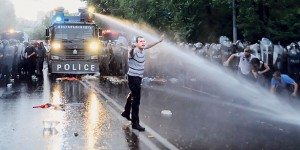 The increase in the price of electricity announced by the Armenian Public Services Regulatory Commission, effective Aug. 1, provoked a great deal of reaction from the people.
The increase in the price of electricity announced by the Armenian Public Services Regulatory Commission, effective Aug. 1, provoked a great deal of reaction from the people.
Demonstrators protested the electricity price hike with a sit-in at Yerevan’s Freedom Square on June 18. The protests, initiated by the “No-to-Robbery” movement, have attracted attention from different parts of the country. Civil society groups argue that the price increase will lead to increases in other areas as well. Some religious clerics also supported the protesters.
The police declared the protests illegal and took measures which caused the situation to descend into chaos. The protesters had previously announced that they would stay on the streets until June 22 and that if no progress was made, they would march towards the Presidential Palace. As of July 1, the protests are still going on.
During the protests, Deputy Energy and Natural Resources Minister Areg Galstyan made statements to address the people’s demands. Noting that he is aware that the price increase will cause hardships, Galstyan underlined that they were unable to generate cheap electricity and thus had no other choice. Speaking at the NATO PA Rose-Roth Seminary held in Yerevan on June 19, Galstyan also added that they understand European concerns over the Metsamor Nuclear Energy plant but that the plant will remain active anyhow because they simply have no other option for energy production.
On June 23 the protesters marched on the palace. President Serzh Sarksyan, who spoke after a lengthy silence, said he could receive a group of representatives but that the others should end the protests. The police chief also said they would take action against the groups so the protesters started a sit-in on Baghramyan Street. The police blocked the alleyways leading to the palace but groups from Gyumri and Sevan joined the protesters in Yerevan. Reports indicate that the police dispersed the protesters and placed 250 people under arrest. Some of the protesters, including media workers and students, faced police brutality.
Civil society activists and members of youth organizations as well as some leading journalists of the country were arrested. Western groups reacted to these arrests; but their voice did not reach Sarksyan. Opposition parties have argued that the administration should reconcile with the protesters whereas some politicians have asked the protesters to pay attention to Sarksyan.
This is not the first time protests were repressed by the police in Armenia. The people have developed a culture of protest throughout the debates on membership in the Eurasian Economic Union. As a former Soviet republic, the country has become a place of influential protests for several reasons. Above all, the Palace is the most influential political actor. The economic situation is deteriorating and ultra-rich oligarchs have profited greatly from the flaws and deficiencies in the economy.
Sarksyan has been pretty cautious in dealing with the demonstrators because the world has paid attention to the protests. He made several calls to end the demonstrations peacefully. Sarksyan, who relied on force and violence to repress similar protests in the past, has relied on a different approach this time. He waited for the protests to dwindle by themselves rather than interfere directly. And this strategy worked. The protests are now less influential because the groups are not led or dominated by strong actors, whether organizations or individual leaders.
The provocative reports in the Russia media also led the protesters to remain cautious. The Russian papers made frequent references to the Maidan protests in Ukraine, which are seen as the beginning of the bloody conflict in the country today. This created a tendency among Yerevan protesters to act carefully. This is why the protesters did not attain their goals.
Armenian version of Gezi protests
Speaking on the demonstrations, political scientist Johnny Melikyan notes that the people are disgruntled with deteriorating living conditions and that some immediate measures should be taken to address deep social and economic problems. Arguing that the economic system should be changed, Melikyan says that the fight against monopoly is the most pressing problem.
Researcher Ashot Sargsyan made an interesting comment on the protests, arguing that they are similar to the 2013 Gezi Park demonstrations in Turkey, adding that the public reaction on the ground turned into demands for recognition of rights. In fact, the pro-government analysts support this view.
Similar developments took place in 2013 when mass protests were staged in response to rumors that the price of natural gas would be increased by 60 percent and that of electricity by 20 percent. The protests included demands for inquiries as to how the oligarchs made their wealth. In the end, the Palace instructed for the removal of some politicians to address the demands of the people.
The rising culture of protest in Armenia did not lead to the adoption of some constructive steps toward a better quality of life. Dependence upon Russia and the wealth of the oligarchs is a source of reaction and controversy though, as the oligarchy is totally in service of Russian interests and this means the failure of social welfare. In recent protests, the people directly spoke to the Palace rather than other politicians. This is taken as a sign of new developments in the country.
Mehmet Fatih ÖZTARSU

 Temmuz 20th, 2015
Temmuz 20th, 2015  oztarsu
oztarsu  Posted in
Posted in  Tags:
Tags: